Lowitz Arcs - 1988 Dover, Delaware
Lowitz Arcs - 1988 Dover, Delaware: A Rare Atmospheric Phenomenon
In the world of atmospheric optics, one of the rarest and most elusive phenomena is the Lowitz arcs. These arcs were first observed and documented in 1988 by Robert Gorkin in Dover, Delaware, USA. Gorkin's images from that day are considered to be the earliest known recordings of complete Lowitz arcs.
During the late 1990s and beyond, the existence of Lowitz arcs was a topic of controversy due to a lack of observations. However, in 1979, pioneering ray tracing methods by Mueller, Greenler, and Mallmann predicted the presence of three Lowitz arcs: an upper arc, a lower arc, and a middle arc. Gorkin's images from 1988 provided visual evidence of these arcs, making them a significant contribution to the study of atmospheric optics.
The Structure of Lowitz Arcs
Lowitz arcs are optical phenomena that occur in the Earth's atmosphere. They are formed by the interaction of sunlight with ice crystals suspended in the air. The crystals responsible for creating Lowitz arcs are regular hexagonal plates with a classical Lowitz orientation, meaning they can rotate a full 360 degrees around the Lowitz axis.
The lower Lowitz arc is the most prominent arc and stretches down from the sundog towards the 22° halo. Above it is the upper arc, which extends upwards to the 22° halo. In some instances, these arcs overlay the 22° halo, and their presence can be best indicated by a weakening of the 22° halo near the parhelion. There is also a middle arc that appears to extend nearly vertically through the parhelion.
Observing Lowitz Arcs
When the sun is between 15-30 degrees above the horizon, the best place to search for an upper Lowitz arc is above the 22° halo rather than near the parhelia. In this region, the upper arc crosses the upper tangent arc and becomes tangent to the Parry arc. Gorkin's images clearly show the presence of the upper arc and also capture arcs near each parhelion.
A Multitude of Atmospheric Phenomena
The observation by Robert Gorkin in 1988 was not only notable for the presence of Lowitz arcs but also for the occurrence of several other atmospheric phenomena. These included an upper Parry arc, a supralateral arc, a circumzenithal arc, and possibly a helic arc. Gorkin's recording may have been one of the earliest sightings of the helic arc, making it a significant contribution to our understanding of this rare phenomenon. Additionally, a bright and vertically elongated 120° parhelion was observed to the east, with the parhelic circle stretching towards the sun.
Image Processing and References
To preserve and enhance the original images captured by Robert Gorkin, R. Eric Young of Young's Studio scanned his original negatives to high-resolution TIFF files. Les Cowley then applied mild filtering techniques to reduce film grain and slightly adjusted contrast and color balance using Photoshop's linear levels control. These minimal manipulations ensured that the images remained faithful representations of the observed atmospheric optics.
For further research and exploration into Lowitz arcs, references to the original works by Lowitz, Mueller, Greenler, and Mallmann are provided. These works laid the foundation for understanding Lowitz arcs and their characteristics.
In conclusion, the 1988 observation of Lowitz arcs in Dover, Delaware marked a significant milestone in the study of atmospheric optics. Robert Gorkin's images provided visual evidence of these elusive arcs, confirming their existence and contributing to our understanding of their structure and behavior. The simultaneous occurrence of other atmospheric phenomena during the observation added to the uniqueness and scientific value of this event. The continued study and documentation of Lowitz arcs will undoubtedly shed more light on these captivating optical phenomena in the future.
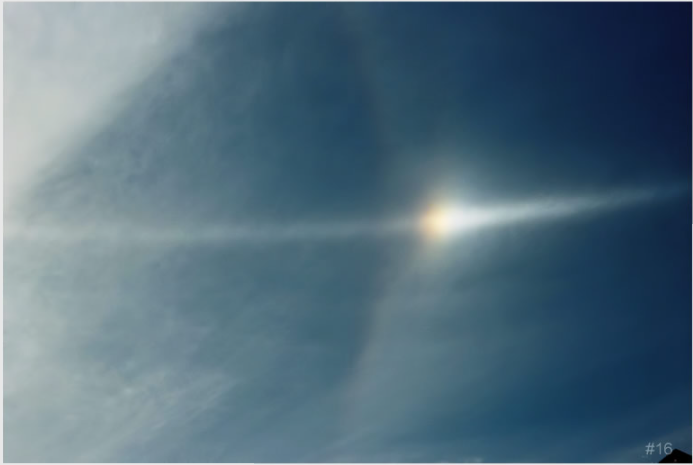
1988 Images.
The earliest known images of complete Lowitz arcs.
Robert Gorkin recorded the display at Dover, Delaware, USA on Tuesday, November 22, 1988 13:15 to 14:00 EST. At left is one of his 24 images recorded on two film rolls.
At this time, and until the late 1990s and beyond, the existence of Lowitz arcs was controversial owing to a dearth of observations.
In 1979, use of pioneering ray tracing methods by Mueller, Greenler and Mallmann predicted three Lowitz arcs, an 'upper', 'lower' and 'middle'. Gorkin's 1988 images are perhaps the earliest that show them.
At top (.16) the lower Lowitz arc, the only one recorded by Lowitz, stretches down from the sundog towards the 22� halo. A fainter arc extends upwards to the 22� halo, the upper arc. In places these arcs overlay the 22� halo and their presence, as here, is often best indicted by weakness of the 22� halo near the parhelion.
There is possibly a middle arc extending nearly vertically through the parhelion. It is slightly more evident in the stacked images at left. Mouse over for a ray tracing comparison.
All images ©Robert Gorkin, shown with permission.
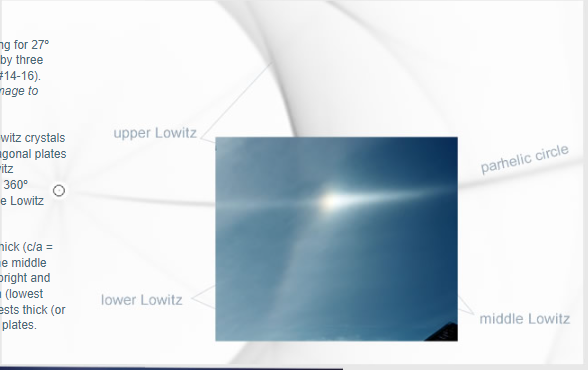
HaloSim ray tracing for 27º high sun overlain by three stacked images (.14-16). Mouse over the image to toggle it on/off.
The simulation Lowitz crystals were regular hexagonal plates with classical Lowitz orientation i.e. full 360º positions about the Lowitz axis.
The plates were thick (c/a = 0.5) to show up the middle Lowitz arc. The bright and tall 120º parhelion (lowest image) also suggests thick (or triangular aspect) plates.
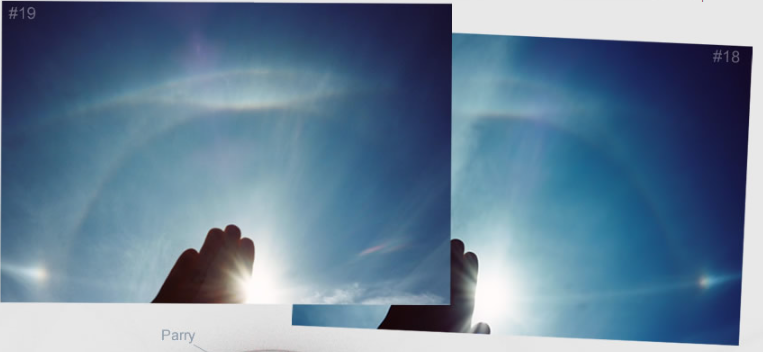
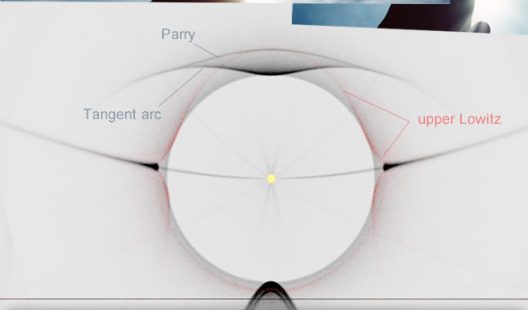
When the sun is 15-30� high the best place to search for an upper Lowitz arc is above the 22� halo rather than near the parhelia. There, it crosses the upper tangent arc and becomes tangent to the Parry arc.
Gorkin's images above (.19,.18 ) show the upper arc clearly. They also show arcs near each parhelion.

Robert Gorkin's notes of the observation written at the time in his day book and partly on the same evening.
The (evening) references (lowest page) are to Robert Greenler's ray tracing simulation predictions in "Rainbows, Halos and Glories".
The display was notable enough besides the Lowitz arcs with an upper Parry arc, supralateral arc, circumzenithal arc and possibly a helic arc - an early recording of the latter. The parhelic circle extended around the sky to a bright 120º parhelion.
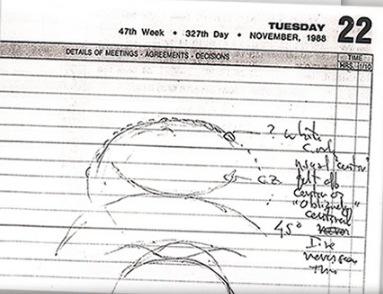

A bright and vertically elongated 120º parhelion to the east. The parhelic circle stretches sunwards.
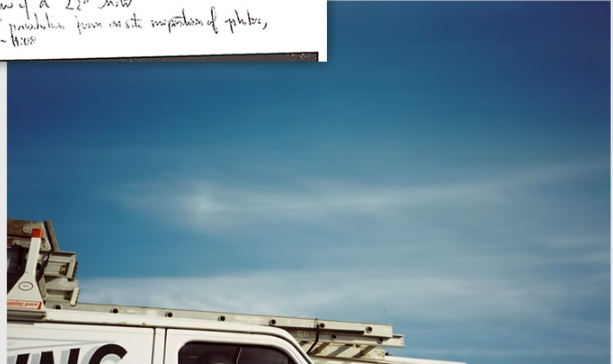
Image processing:
R. Eric Young of Young's Studio scanned Robert Gorkin's original negatives to 1800x1204 24bit TIFF files. Les Cowley mildly filtered the TIFFs to reduce film grain. The only further manipulation was to slightly adjust contrast and colour balance using the linear levels control in Photoshop.
References:
Lowitz, T., Nova Acta Acad Sci Imperialis Petropolitanae, 8, 384 (1794)
Mueller J R, Greenler R G and Mallman A J., JOSA 69, 1103 (1979) and citations there.
Greenler, Robert, "Rainbows, Halos and Glories", Cambridge, 1980
Note: this article has been automatically converted from the old site and may not appear as intended. You can find the original article here.
Reference Atmospheric Optics
If you use any of the definitions, information, or data presented on Atmospheric Optics, please copy the link or reference below to properly credit us as the reference source. Thank you!
-
<a href="https://atoptics.co.uk/blog/lowitz-arcs-1988-dover-delaware/">Lowitz Arcs - 1988 Dover, Delaware</a>
-
"Lowitz Arcs - 1988 Dover, Delaware". Atmospheric Optics. Accessed on December 22, 2024. https://atoptics.co.uk/blog/lowitz-arcs-1988-dover-delaware/.
-
"Lowitz Arcs - 1988 Dover, Delaware". Atmospheric Optics, https://atoptics.co.uk/blog/lowitz-arcs-1988-dover-delaware/. Accessed 22 December, 2024
-
Lowitz Arcs - 1988 Dover, Delaware. Atmospheric Optics. Retrieved from https://atoptics.co.uk/blog/lowitz-arcs-1988-dover-delaware/.